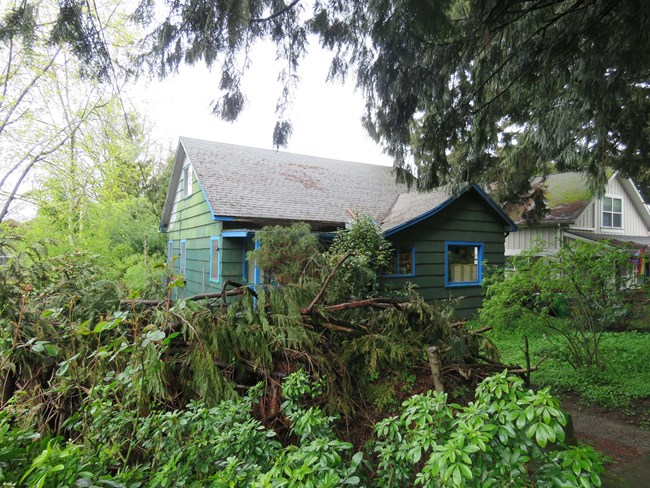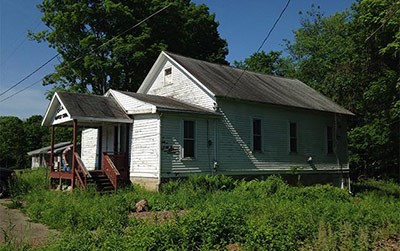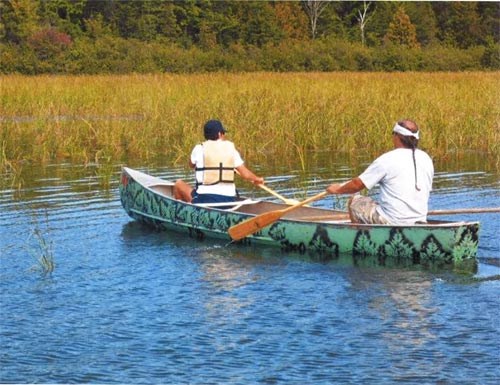The National Register of Historic Places is the official list of the Nation's historic places worthy of preservation. Authorized by the National Historic Preservation Act of 1966, the National Park Service's National Register of Historic Places is part of a national program to coordinate and support public and private efforts to identify, evaluate, and protect America's historic and archeological resources.
The National Register of Historic Places is pleased to promote awareness of and appreciation for the history and culture of American Indians and Alaska Natives during National American Indian Heritage Month.

Photograph by Caitlin Ewers, courtesy of the Oregon State Historic Preservation Office
New Listings in the National Register
Jim Pepper House in Parkrose, Portland
The property is significant as the childhood home of Kaw and Muscogee Creek jazz saxophonist Jim Pepper, who melded Native American musical traditions with jazz and rock.
Pepper is perhaps most famous for producing the song "Witchi Tai To" in 1968, and his debut album, "Pepper's Pow Wow," in 1971. For decades he toured prolifically across New York, Alaska, Europe, and West Africa.
Millie Woodson-Turner Home Site, Capron, Virginia
The site is significant as an example of a Nottoway reservation allotment, a division of land that transformed the way the Nottoway people distributed and owned land beginning in the 1830s. In 1705, the Nottoway reservation was formally established in present-day Sussex and Southampton counties, at a significant reduction from traditional Nottoway lands. Due to economic hardship, many Virginia tribes including the Nottoway were forced to sell portions of their land that were not actively being used by tribe members. Deeming the Nottoway incapable of managing the sale of these lands, the colonial government appointed white trustees to oversee these sales and distribute the funds.
Past Highlights

Photograph by Nathan Montague, courtesy of Seneca Nation of Indians Tribal Historic Preservation Office
The Allegany Council House served as the primary gathering place for regular meetings of the Seneca Council beginning in 1926. Over the next forty years, the Allegany Council House served as the governmental center of the Seneca Nation. During this time, the building served as the socio-political epicenter for two major, nearly simultaneous Seneca Nation battles: to halt the Kinzua Dam Project and to obtain the right to vote for Seneca women. Although the nation was ultimately unable to prevent the United States government from building the Kinzua Dam, the controversial event mobilized the Senecas in their efforts to resist the taking of their land. Furthermore, Seneca women played an important leadership role at the Allegany Council House beginning in 1935, when they first petitioned the council for the right to vote.

Photograph courtesy of Michigan of State Historic Preservation Office
Centered around the gathering of wild rice, the village founded at Ketegitigaaning provides an uncommon example in the region of both a traditional, off-reservation community, as well as an area of lakeshore that has been Ojibwe-owned for generations. The establishment of an economy based on wild rice contributed to a distinct cultural identity which differentiated the Ketegitigaaning community from the Lake Superior Ojibwe and non-Ojibwe cultures of the surrounding region.
Iowa Tribe Community Building
White Cloud, Kansas
The Iowa Tribe Community Building was completed in 1940 on tribal lands of the Iowa Tribe of Kansas and Nebraska reservation, about five miles west of White Cloud. The building was constructed by tribal members as part of the New Deal-era Civilian Conservation Corps' Indian Division (CCC-ID), a subset of the Works Progress Administration (WPA). The building has served the needs of the Iowa Tribe community over the years as a meeting place for cultural and social events, dances, powwows, funerals, feasts, religious services, social programs, tribal government meetings, and administration.
Wassillie Trefon Dena'ina Fish Cache
Lake and Peninsula Borough, Alaska
The Wassillie Trefon Fish Cache is the last best example of the traditional Dena' ina Athabascan fish cache in the Lake Clark-Iliamna area. Indeed, it is very likely to be the best example of a southwestern Alaska Native log cache extant in the entire Bristol Bay region.
Indian Mounds Park Mound Group
St. Paul, Minnesota
The Indian Mounds Park site in St. Paul, Minnesota is unique for preserving the only remaining burial mounds within the Minneapolis-St. Paul urban core, which roughly overlies the traditional cultural hub of the Dakota. This sacred site provided a nucleus for burial rituals over thousands of years throughout the Middle Woodland Tradition and likely into the early historic period.
Lawetlat'la (Mount St. Helens)
Gifford Pinchot National Forest, (Skamania and Cowlitz Counties), Washington
is directly associated with the traditional beliefs of the Cowlitz Indian Tribe and the Yakama Nation regarding origins, cultural history, and nature of the world. Those beliefs are rooted in tribal history and are important in maintaining the cultural continuity of the tribal community.
Chief Son-I-Hat's Whale House and Totems Historic District
Prince of Wales-Outer Ketchikan, Alaska
"…a name once given (to a clan house) survive(s) the mere structure."
The site includes a traditional longhouse, nine free-standing totem poles, two cemeteries, and a bridge and trail connecting the features.
Hassanamisco Reservation
Worcester County, Massachusetts
The reservation is unique in Massachusetts for never have been owned or occupied by non-native people. The Hassanamisco Reservation has been the property of the members of the Nipmuc Tribe and has never been alienated from tribal ownership during the past 400 years.
Red Barn
Glades County, Florida
The barn stands proudly as a reminder of the days when the cattle industry brought a newfound source of income, democracy and independence to the Seminole tribe.
Snoqualmie Falls
King County, Washington
It is related among the Snoqualmie that Moon the Transformer created the falls from a fishing weir (a trap created to trap fish while letting water run through) while he was giving shape to the natural environment and the Indian people.
Black Hawk Powwow Grounds
Jackson County, Wisconsin
The powwow grounds, in Jackson County, Wisconsin, have been used as a ceremonial and social event center, as well as a dance-ring or powwow ground, since at least the late 1800’s and possibly well before.
Bainbridge Ferry
Cape Girardeau County, Missouri
The Bainbridge Ferry, in Cape Girardeau County, Missouri, is the location where thousands of people from the Cherokee Nation were transported across the Mississippi River from November 1837 and January 1839, during the Cherokee Trail of Tears.
Picotte Memorial Hospital, Walthill, Nebraska
This National Historic Landmark is a one and one-half story frame building that was constructed in 1912-13 to serve as a facility for the practice of Dr. Picotte, the first American Indian woman to practice medicine in the United States.
Cuyler Presbyterian Church, Brooklyn, Kings County, New York
Reverend Cory welcomed American Indians to his church. Learning their language was only one of the ways he met his new congregants on their own terms. He also translated religious readings into the Mohawk-Oneida dialect, and promoted the reacquisition of Indian traditional culture, making the resources of the church available to the native community for that purpose.
Effigy Mounds National Monument, northeastern part of Iowa
At the present time, 191 mounds are preserved within the monument, 29 of which are animal-shaped mounds.
Ponca Tribal Self-Help Community Building Historic District, Nebraska
A meeting place, learning and cultural center for the Ponca Tribe
Southwestern Range and Sheep Breeding Laboratory Historic District, New Mexico
Part of a New Deal program to improve sheep breeding and wool production and preserve Navajo culture
Campus Center, Alaska
Site of the Alaska Federation of Natives conference of 1971
Indian Creek State Park, San Juan County, UT
Newspaper Rock Petroglyph Panel, located in this park, is a fine example of Ute art work and that of earlier cultures.
Navajo Nation Council Chamber, Window Rock, AZ
Center of government for the Navajo Nation and a symbol of the New Deal revolution in federal Indian policy during the 1930s.
Alaska Native Brotherhood Hall, Sitka, AK
Home to the original chapter of an organization representing the interests of Alaska natives.
Pascua Cultural Plaza, Tucson, AZ
A sacred ceremonial site for the Yoeme (Yaqui) people, where the community's traditions continue today.
Hydaburg Totem Park, Hydaburg, AK
A park established by the federal government and local Native Alaskans to protect their works of art and culture
Chilocco Indian Agricultural School, Newkirk, OK
An off-reservation agricultural school for Native American Indian children from tribes across the country.
White Eagle Park, Kay County, OK
The Ponca Powwow, held annually at the White Eagle Park in Kay County, Oklahoma, has disseminated elements of Ponca culture to other tribes, establishing the template for the intertribal contest powwow now practiced nationally.
Weippe Prairie, Nez Perce National Historical Park, ID
It was on the Weippe Prairie that the Nez Perce tribe befriended the Expedition led by Captains Meriwether Lewis and William Clark in 1805-1806.
Wupatki National Monument, Coconino County, AZ
What began as family housing grew into Wupatki Pueblo that stood three stories high in
places.
Learn More
Telling All Americans' Stories: Indigenous Heritage
American Indian Properties featured in Teaching with Historic Places Lesson Plans
American Indian Heritage in National Parks
NPS Working with Native Americans
National Register of Historic Places Flickr Photostream: tagged American Indian
National Register of Historic Places Flickr Photostream: tagged Alaska
Historic Documentation Programs (HABS/HAER/HALS) collection tagged: Indians of North America at the Library of Congress
National Association of Tribal Historic Preservation Officers
Last updated: November 9, 2023
